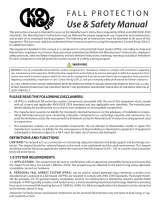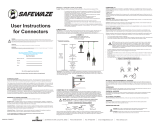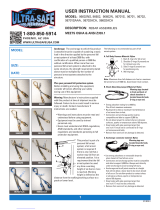
A Capital
Safety
Brand
PRO SERIES
SHOCK ABSORBING
LANYARD
This manual is intended to meet the
Manufacturer’s Instructions as required
by the following standards and should
be used as part of an employee
training program as required by OSHA:
Certificate No. FM 39709
9001
ANSI Z359.1
CSA Z259.11
WARNING: This product is part of a personal
restraint, work positioning, suspension, or rescue
system. The user must read and follow the
manufacturer’s instructions for each component
or part of the complete system. These instructions
must be provided to the user of this equipment.
The user must read and understand these
instructions or have them explained to them before
using this equipment. Manufacturer’s instructions
must be followed for proper use and maintenance
of this product. Alterations or misuse of this
product or failure to follow instructions may result
in serious injury or death.
IMPORTANT: If you have any questions on
the use, care, application, or suitability for use of
this equipment, contact CAPITAL SAFETY.
IMPORTANT: Before using this equipment
record the product identication information
(from the I.D. label) onto the inspection and
maintenance log.
PURPOSE: PROTECTA Energy Absorbing Lanyards
and Energy Absorbers are intended to be used as part
of a personal fall arrest system. Applications include
activities where there exists the possibility of a fall.
LIMITATIONS: Consider the following application
limitations before using this equipment:
CAPACITY: This equipment is for use by one person
with a combined weight (refer to standard).
PHYSICAL AND ENVIRONMENTAL HAZARDS:
Use of this equipment in areas containing physical or
environmental hazards may require that additional
precautions be taken to reduce the possibility of
damage to this equipment or injury to the user.
Hazards may include, but are not limited to: high heat,
strong or caustic chemicals, corrosive environments,
the possibility of electric current flowing through this
equipment when working near high voltage power
lines, explosive or toxic gases, moving machinery, or
sharp edges. Contact CAPITAL SAFETY if you have
any questions about the application of this equipment
TRAINING: This equipment is intended to be
installed and used by persons who have been
properly trained in its correct application and use.
APPLICABLE STANDARDS: Refer to national standards
including ANSI Z359.1, CSA Z259.11 (Canada), and
local, state, federal (OSHA 1910.66 and 1926.500), and
Capital Safety requirements for more information.
COMPATIBILITY OF COMPONENTS: PROTECTA
equipment is designed for use with PROTECTA approved
components and subsystems only. Substitutions
may jeopardize compatibility of equipment and
effect the safety and reliability of the system.
COMPATIBILITY OF CONNECTORS: Connectors
are considered to be compatible with connecting
elements when they have been designed to work
together in such a way that their sizes and shapes
do not cause their gate mechanisms to inadvertently
open regardless of how they become oriented.
Connectors (hooks, carabiners, and D-rings) must be
capable of supporting at least 5,000 lbs. (22.2 kN).
Connectors must be compatible with the anchorage
or other system components. Do not use equipment
that is not compatible. Non-compatible connectors may
unintentionally disengage. See Figure 1. Connectors
must be compatible in size, shape, and strength.
MAKING CONNECTIONS: Only use self-locking snap
hooks and carabiners. Only use connectors that are
suitable to each application. Ensure all connections
are compatible in size, shape and strength. Ensure
all connectors are fully closed and locked.
See Figure 2 for inappropriate connections. PROTECTA
snap hooks and carabiners should not be connected:
To a D-ring to which another connector is attached and
in a manner that would result in a load on the gate.
NOTE: Unless equipped with a 3600 lb. (16kN)
rated gates, large throat-opening snap hooks
should not be connected to standard size D-rings
or similar objects which will result in a load on
the gate if the hook or D-ring twists or rotates.
Large throat snap hooks are designed for use on
xed structural elements such as rebar or cross
members that are not shaped in a way that can
capture the gate of the hook.
In a false engagement, where features that protrude
from the snap hook or carabiner catch on the anchor,
and without visual confirmation seems to be fully
engaged to the anchor point or to each other.
Directly to webbing or rope lanyard or tie-back (unless
the manufacturer’s instructions for both the lanyard
and connector specifically allows such a connection).
To any object which is shaped or dimensioned
such that the snap hook or carabiners will not
close and lock, or that roll-out could occur.
FIGURE 1
If the connecting element that a snap hook
(shown) or carabiner attaches to is undersized or
irregular in shape, a situation could occur where
the connecting element applies a force to the
gate of the snap hook or carabiner. This force
may cause the gate (of either a self-locking or
a non-locking snap hook) to open, allowing the
snap hook or carabiner to disengage from the
connecting point.
1. Force is
applied to the
snap hook.
2. The gate
presses against
the connecting
ring.
3. The gate
opens allowing
the snap hook
to slip off.
ANCHORAGE STRENGTH: Anchorages selected for
personal fall arrest systems (PFAS) shall have a strength
capable of sustaining static loads, applied in the directions
permitted by the PFAS, of at least: (A) 3,600 lbs. (16
kN) when certication exists (reference ANSI Z359.1 for
certication denition), or (B) 5,000 lbs. (22.2 kN) in
the absence of certication. When more than one PFAS
is attached to an anchorage, the anchorage strengths
set forth in (A) and (B) above must be multiplied by
the number of PFAS attached to the anchorage.
From OSHA 1926.500 and 1910.66: Anchorages used
for attachment of PFAS shall be independent of any
anchorage being used to support or suspend platforms,
and capable of supporting at least 5,000 lbs. (22.2 kN)
per user attached, or be designed, installed, and used as
part of a complete PFAS, which maintains a safety factor
of at least two, and is supervised by a qualied person.
Figure 2
WARNING: Do not alter or intentionally
misuse this equipment. Use caution when using
around moving machinery, electrical hazards,
chemical hazards, and sharp edges.
WARNING: Consult your doctor if there is
reason to doubt your tness to safely absorb the
shock from a fall arrest. Age and tness seriously
affect a worker’s ability to withstand falls. Pregnant
women or minors must not use PROTECTA energy
absorbing lanyards.
BEFORE EACH USE of this equipment, carefully inspect
it to assure that it is in good working condition. Check for
wear or damage. Ensure hardware is present and secure,
and is not distorted. Ensure self-locking snap hooks or
carabiners work properly. Inspect rope or webbing for wear,
cuts, burns, frayed edges, breaks, or other damage. Do not
use if inspection reveals an unsafe condition.
PLAN your fall protection system before starting
your work. Take into consideration factors that affect
your safety before, during, and after a fall. Consider
the following when planning your system:
ANCHORAGE: Select a rigid anchorage point that is capable
of supporting the required loads. The anchorage location
must be carefully selected to reduce possible free fall and
swing fall hazards and to avoid striking an object during a
fall. The anchorage should be generally level (horizontal)
to prevent the connector from sliding down an incline
when in use, which could cause serious injury to the user.
FREE FALL: Personal fall arrest systems must be rigged
such that the potential free fall is never greater than
6 feet (1.83 m). Avoid working above your anchorage
level to avoid an increased free fall distance.
FALL ARREST FORCES: The assembled fall arrest
system must keep fall arrest forces below 1,800
lbs. (8 kN) when used with a full body harness.
FALL CLEARANCE: Should a fall occur, there must be
sufficient clearance in the fall area to arrest the fall before
striking the ground or other object. Energy absorbers
can extend the fall arrest distance by up to 42 inches
(107 cm). Figure 3 shows how to estimate fall clearance
distance when using an energy absorbing lanyard or energy
absorber subsystem. Other factors may influence the
required clearance distances. For example, using an energy
absorbing lanyard or energy absorber with a rope grab (fall
arrestor) may require additional clearance due to stretch in
the lifeline or sliding of the rope grab on the lifeline during
fall arrest. Some full body harness models incorporate
a sliding (positional) D-ring in the back as the fall arrest
attachment. Movement of this D-ring during fall arrest can
increase the fall clearance distance required. Use caution
when assembling system components that could act to
extend the fall arrest distance (and therefore fall clearance
required). Refer to manufacturer’s instructions for
each part of the system for more information on fall
clearance.
Figure 3
“FFD” =Free Fall Distance
“DD” =Energy Absorber Deceleration
Distance (3 1/2 ft. or 106.68 cm)
“H” =Height to dorsal connector when
worker is suspended
“C” =Clearance to obstruction during
fall arrest (1 1/2 ft. or 45.72 cm
required)
“RD” =Required distance below
working surface to nearest
obstruction
“RD” =”FFD” + “DD” +”H” + “C”
Working
Surface
Required Distance
below working surface
to nearest obstruction
“RD”
Nearest
Obstruction
Free Fall Distance “FFD”
6 Feet or 182.88 cm
Maximum Allowed
Energy Absorber
Deceleration Distance “DO”
Height to dorsal
connector when worker is
suspended “H”
SWING FALLS: See Figure 4. Swing falls occur when
the anchorage point is not directly above the point
where a fall occurs. The force of striking an object in a
swing fall may cause serious injury or death. Minimize
swing falls by working as close to the anchorage point as
possible. Do not permit a swing fall if injury could occur.
© Copyright 2010, DB Industries, Inc.
FORM NO: 5902281 REV: E











